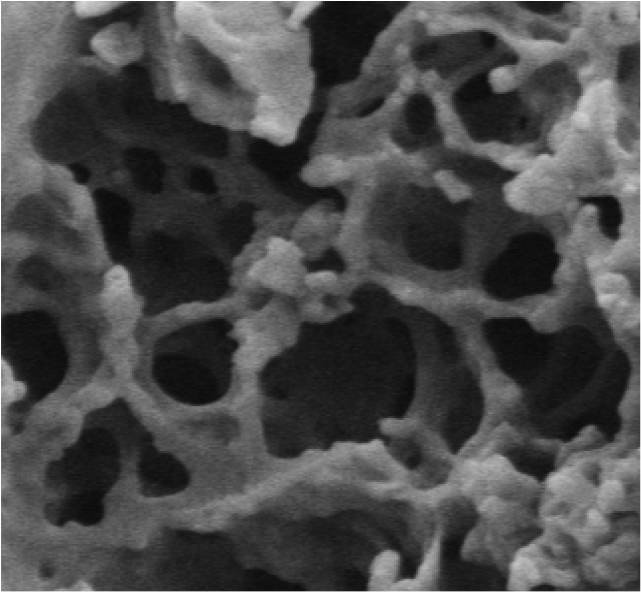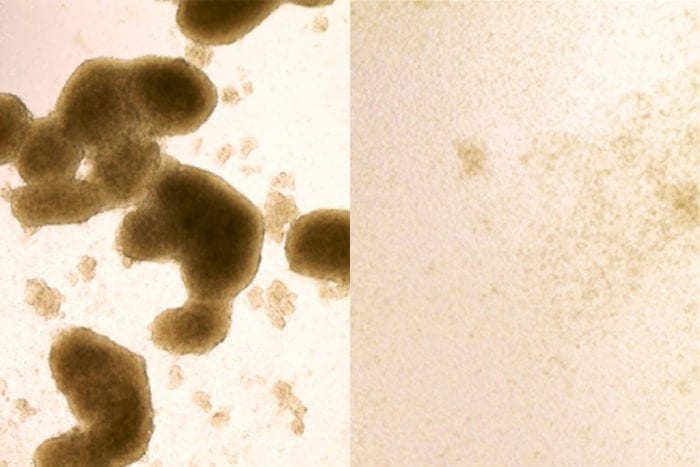
via University of Wisconsin–Madison
Like the hardiest weed, glioblastoma almost always springs back — usually within months after a patient’s initial brain tumor is surgically removed. That is why survival rates for this cancer are just 25 percent at one year and plummet to 5 percent by the five-year mark.
One of the challenges of treating this disease is that surgeons can’t always remove every bit of tumor or glioma stem cells that might linger in the brain.
“One characteristic of glioblastoma is that the tumor cells are very aggressive, and they will infiltrate the surrounding tissues. So the surgeon can’t clearly feel the boundaries between the tumor and the normal tissue, and you cannot remove as much as possible because all the tissues in the brain are extremely important — you certainly don’t want to remove too much,” explains Quanyin Hu, an assistant professor in the University of Wisconsin–Madison School of Pharmacy’s Pharmaceutical Sciences Division. “So the tumor will come back again, and that sharply decreases the survival rate after treatment.”
But Hu’s Cell-Inspired Personalized Therapeutic (CIPT) Lab has developed a powerful immunity-boosting postoperative treatment that could transform the odds for patients with glioblastoma. Hu and his collaborators published their research on the treatment’s use in mouse models of human glioblastoma this month in the journal Science Translational Medicine.
“It provides hope for preventing glioblastoma relapse,” Hu says. “We prove that it can actually eradicate these glioma stem cells, which can eventually prevent the glioblastoma from coming back. We can significantly improve survival.”
Hu’s lab developed a hydrogel that can be injected into the brain cavity left behind by the excised tumor. The hydrogel delivery method works well because it completely fills the brain cavity, slowly releases the medicine into the surrounding tissue, and promotes the cancer-killing immune response, Hu notes.
“We have a lot of work to do before it can be potentially translated into the clinic, but we feel confident that this is a very promising approach for bringing new hope to patients with glioblastoma so they can recover after surgery.”
Quanyin Hu
The hydrogel is packed with nanoparticles designed to enter and reprogram certain types of immune cells called macrophages. These immune cells normally clean up infectious invaders in the body, but in the tumor environment, they can change into a form that instead suppresses the immune system and promotes cancer growth. And because of the inflammation created by surgery, these rogue macrophages flock to the surgical site, potentially fueling cancer relapse.
“We want to take advantage of these macrophages and turn them from enemy to ally,” Hu says.
To do that, the nanoparticles can engineer the macrophages to target a glycoprotein called CD133, a marker for cancer stem cells. Hu’s team also added an antibody, CD47, that blocks a “don’t-eat-me” signal to promote macrophages to recognize the cancer cells. The preclinical results in mice models show that the hydrogel treatment successfully generated glioma stem cell-specific chimeric antigen receptor (CAR) macrophages — essentially engineering the immune cells on site to target and kill any lingering glioma stem cells.
If effective in humans, the hydrogel treatment could eliminate the need for postsurgical chemotherapy or radiation, reducing toxic side effects while also improving patient outcomes.
Hu’s next step is testing the hydrogel in larger animal models and also monitoring long-term efficacy and toxicity beyond the four- to six-month period he previously studied.
“We have a lot of work to do before it can be potentially translated into the clinic, but we feel confident that this is a very promising approach for bringing new hope to patients with glioblastoma so they can recover after surgery,” Hu says. “We hope we can do our work to be able to advance this technology to the clinic.”
While Hu’s team is initially focused on glioblastoma, the treatment approach could also be applied to other aggressive solid tumors, including breast cancer, he notes. “Our approach is taking advantage of the macrophages in the postsurgical areas and to locally engineer these macrophages,” he says. “In this scenario, we can confidently say that it will apply to the majority of solid tumors with high invasive characteristics.”
Original Article: New injectable gel offers promise for tough-to-treat brain tumors
More from: University of Wisconsin-Madison
The Latest Updates from Bing News
Go deeper with Bing News on:
Immunity-boosting postoperative treatment
- Hacking the immune system could slow ageing — here’s how
Yet all she had done was to briefly treat them — many weeks earlier — with a drug that corrected the organization of proteins inside a type of stem cell. When technicians who were replicating her ...
- Expanding a lymph node, boosting a vaccine
For the first time, researchers from the Wyss Institute for Biologically Inspired Engineering at Harvard University, Harvard John A. Paulson School of Engineering and Applied Sciences (SEAS), ...
- Targeting protein interactions may boost antitumor immunity in breast cancer
A multi-institutional team of investigators has discovered that targeting a specific protein interaction within immunosuppressive breast cancer cells may increase antitumor immune responses in ...
- Cancer immunity gets a boost from one common nutrient, study finds: ‘Intrigue and optimism’
A study of mice published in the journal Science last week found that eating a diet rich in vitamin D changed the gut microbiome in a way that boosted cancer immunity. The micronutrient increased ...
- Cancer immunity gets a boost from one common nutrient, study finds: ‘Intrigue and optimism’
"This could one day be important for cancer treatment in humans ... "By exploring new ways to boost the immune system's ability to recognize and destroy cancer cells, researchers can develop ...
Go deeper with Bing News on:
Hydrogel delivery method
- Novel fabrication method creates aligned nanofiber hydrogels for tissue regeneration
A team of chemists and bioengineers at Rice University and the University of Houston have achieved a significant milestone in their work to create a biomaterial that can be used to grow biological ...
- Skin Care News
Apr. 2, 2024 — Polymer-based hydrogels are used to treat skin ailments ... The peptide has been used as a delivery vehicle ... Feb. 12, 2024 — A study has demonstrated that the appearance ...
- Technion breakthrough for better drug delivery and tissue implantation
Researchers develop ultrasound for non-invasive method for bio-printing live cells and tissues deep within the body.
- HKU Mechanical Engineering researchers develop miniaturised electric generators based on hydrogels for use in biomedical devices
Mechanoelectrical energy conversion offers a promising solution for powering miniaturised biomedical devices, such as cardiac pacemakers, brain stimulators, wearable drug delivery systems ...
- Got a chronic disease and fear of needles? A prick-free natural alternative is on the horizon
"So, this method of drug delivery is more specific and more effective. It can handle high temperatures and acidities, cause fewer side effects, and doesn't break down as quickly. This hydrogel ...










